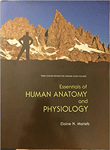
Concept explainers
More than one choice may apply.
The major endocrine organs of the body
a. tend to be very large organs.
b. are closely connected with each other.
c. all contribute to the same function (digestion).
d. tend to lie near the midline of the body.
Introduction:
The endocrine system is the second control system of the body after nervous system. It releases hormones, which, in turn, regulate complex body processes like growth, metabolism, and reproduction. These hormones are released by major endocrine organs namely, the pituitary, pineal, thyroid, parathyroid, thymus and adrenal glands, pancreas, and gonads.
Answer to Problem 1MC
Correct answer:
Although a few endocrine organs and tissues are situated in the separate regions of the body, all the major endocrine organs are present in the close vicinity of the midline of the human body.
Explanation of Solution
Explanation for the correct answer:
Option (d) is given that all the major endocrine organs lie close to the midline of the body. The major endocrine organs of the body include pituitary, pineal, hypothalamus, thyroid, parathyroid, thymus and adrenal glands, pancreas, and gonads (ovaries and testes) that generally lie in the midline in the anatomical plane of the human body. Hence, option (d) is correct.
Explanation for incorrect answers:
Option (a) is given that endocrine organs tend to be very large. The organs of the endocrine system are of all sizes, some being very small (like pineal and pituitary glands) and others being large (thyroid gland). So, it is an incorrect option.
Option (b) is given that all the endocrine organs are connected to each other. The endocrine organs are situated in different places in the body. So, it is an incorrect option.
Option (c) is given that all organs of the endocrine system control the same function. The endocrine glands exhibit distinct functions. The thyroid gland is involved in the growth and development of body tissues, whereas gonads are for reproductive functions. So, it is an incorrect option.
Hence, options (a), (b), and (c) are incorrect.
The endocrine system consists of organs that are specialized to regulate various body processes. They secrete chemical messengers called hormones, which act on the target cell and control their functions.
Want to see more full solutions like this?
Chapter 9 Solutions
Essentials of Human Anatomy and Physiology (Custom)
- 18. Watch this short youtube video about SARS CoV-2 replication. SARS-CoV-2 Life Cycle (Summer 2020) - YouTube.19. What is the name of the receptor that SARS CoV-2 uses to enter cells? Which human cells express this receptor? 20. Name a few of the proteins that the SARS CoV-2 mRNA codes for. 21. What is the role of the golgi apparatus related to SARS CoV-2arrow_forwardState the five functions of Globular Proteins, and give an example of a protein for each function.arrow_forwardDiagram of check cell under low power and high powerarrow_forward
- a couple in which the father has the a blood type and the mother has the o blood type produce an offspring with the o blood type, how does this happen? how could two functionally O parents produce an offspring that has the a blood type?arrow_forwardWhat is the opening indicated by the pointer? (leaf x.s.) stomate guard cell lenticel intercellular space none of thesearrow_forwardIdentify the indicated tissue? (stem x.s.) parenchyma collenchyma sclerenchyma ○ xylem ○ phloem none of thesearrow_forward
- Where did this structure originate from? (Salix branch root) epidermis cortex endodermis pericycle vascular cylinderarrow_forwardIdentify the indicated tissue. (Tilia stem x.s.) parenchyma collenchyma sclerenchyma xylem phloem none of thesearrow_forwardIdentify the indicated structure. (Cucurbita stem l.s.) pit lenticel stomate tendril none of thesearrow_forward
- Identify the specific cell? (Zebrina leaf peel) vessel element sieve element companion cell tracheid guard cell subsidiary cell none of thesearrow_forwardWhat type of cells flank the opening on either side? (leaf x.s.) vessel elements sieve elements companion cells tracheids guard cells none of thesearrow_forwardWhat specific cell is indicated. (Cucurbita stem I.s.) vessel element sieve element O companion cell tracheid guard cell none of thesearrow_forward
- Essentials of Pharmacology for Health ProfessionsNursingISBN:9781305441620Author:WOODROWPublisher:Cengage
 Human Physiology: From Cells to Systems (MindTap ...BiologyISBN:9781285866932Author:Lauralee SherwoodPublisher:Cengage Learning
Human Physiology: From Cells to Systems (MindTap ...BiologyISBN:9781285866932Author:Lauralee SherwoodPublisher:Cengage Learning - Lifetime Physical Fitness & WellnessHealth & NutritionISBN:9781337677509Author:HOEGERPublisher:Cengage





